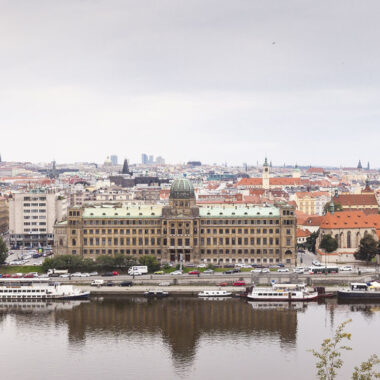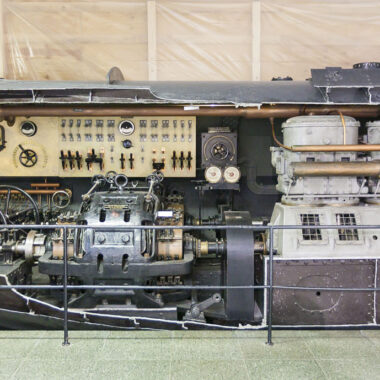The words “new” and “old” have a bit of a different meaning in the centuries-old city of Prague. Our digs for our few days in Prague’s New Town – Nové Město – were in a UNESCO World Heritage Site building that was almost 800 years old. New? I guess, by Prague’s standards, given that Prague’s Old Town – Staré Město – was founded in the ninth century! I haven’t put many photos of our various accommodations throughout Europe on the blog, but the quaint apartment where we stayed inNové Město was quite unique, with its striking high ceilings and expansive windows looking out onto the bustling street below. It wasn’t without its quirks – the building’s designation as a UNESCO World Heritage Site means that none of the building’s structure or even windows can be altered – but it was a quite a unique spot to spend a few nights.
Prague was such a hip and diverse city, with its endless array of art galleries and designer fashion stores mixed in with countless brewpubs and the most impressive Gothic architecture I’d ever seen.Nové Město, where we stayed, and adjacentStaré Město were a constant hive of activity. Mostly untouched by war, the cathedrals and architectural relics of Prague were incredibly impressive, especially those lining the cobblestone alleyways and streets ofStaré Město. Chrám Matky Boží Před Týnem was an awe-inspiring sight in the afternoon sun. The cobblestones themselves were actually quite a feature of central Prague, with their ever-changing colors and designs as we hopped from block to block on foot. The kids created a few games for themselves as we strolled, with rules about which patterns were permitted for walking and penalties for deviating from certain colored stones. (We actually came across a sidewalk cobblestone mason one afternoon, stopping to watch him work as he was repairing a section of sidewalk. He worked with astonishing speed, but such backbreaking work bent down on the sidewalk day after day!)Staré Město was also without a doubt the largest concentration of Rolls Royces, Maseratis, Ferraris and Aston Martins I’d ever seen. Some serious wealth!
We spent a morning in Prague’s Lesser Town – Malá Strana – which is a borough located a short stroll fromStaré Město across the Charles Bridge. It was distinctly less touristy thatStaré Město, and was a mostly residential area of the city with a handful of embassies and music conservatories dotted throughout the neighborhood. As with everywhere in Prague, beer was a staple in Lesser Town, where I noticed quite a few of the outdoor tables at pubs already busy with patrons downing steins at 10AM on a weekday! We walked past Prague’s oldest pub in Lesser Town, it was the wrong time of day (for us, anyway!) for a beer but the 700+ year old U Krále Brabantského was like something out of a Game of Thrones movie set. Our stop at Café Kafíčko for morning tea was primarily dedicated toward sampling some Czech medovnik (honey cake). The molasses- and honey-rich cake intermingled with layers of sour cream and topped with walnuts was decidedly delicious. Lesser Town is also home to Prague Castle and the commanding Saint Vitus Cathedral. The cathedral was without a doubt the most impressive cathedral I’d ever had the fortune to visit: incredible not only due to its behemoth size, but also the amazing intricacy of the exterior structure coupled with all the mosaics and artwork decorating the facade. Truly a sight to behold. (Max and Lilia did some commendable work with my SLR for one or two rare shots of me in front of the cathedral, nice work kiddos!)
With its huge expat and immigrant communities – I read that “Nguyen” was once the fourth most popular surname in Prague due to all the Vietnamese immigrants – the cuisine of offer was very diverse. Within a block of our apartment inNové Město we could choose between Asian street food, sushi, kebabs, Indian and all the way through to traditional Czech brewhouses. Our AirBNB host was a wealth of information on Prague and steered us towards a handful of fun eateries that were a little off the tourist track. Our night at U Fleků was a super fun evening dining and drinking house made beer at the brewpub’s central beer garden with an accordion belting out Czech folk tunes in the background. The waiters were constantly circling with platters of house made brew, from which we had two choices: light or dark. The pork knuckle we sampled was a little different to the delicious fare we enjoyed in Znojmo – more smoky and not quite as delicate – but still very delicious.
Another notable eatery was in the wealthy Jewish Quarter ofStaré Město, where we stopped for lunch on one of our days in town: the butcher Naše Maso had some exceptional cuts of meat and would cook any of them for a small fee, as well as offering a modest menu of sandwiches and burgers. They also had a separate section of the store with house-cured cold cuts and some tasty looking breads. To my astonishment, Max devoured his huge plate of meatloaf without bursting his stomach and Lisa’s pastrami sandwich was the best she’d ever had. I really don’t like meatloaf, but I will admit the example served up by Naše Maso was quite devourable. The cheeseburger I shared with Lilia was also exceptional (but I don’t think quite as good as my horse burger in Ljubljana…). A unique spot for a quick bite, quite a cool concept.
We mixed in a stop for the kids during our time in Prague (which actually doubled as something Lisa and I quite enjoyed as well!). The Museum of the Senses is a concept we’d seen in one or two cities across Europe and decided it would be a good reprieve from history for the kids for a few hours. Some of the optical illusions were mind-bending, especially the tunnel vortex and distortion room. I think the latter was everyone’s favorite (Lisa almost hurled in the tunnel vortex so I know she wouldn’t put that one near the top of her list). The photos below in the distortion room were not edited by me in any way. The way the room was constructed made it appear the person standing on the right was significantly larger than the person on the left. Lots of fun for all.
We ventured east out of the touristy area in Prague a couple of times into the Žižkov and Vinohrady districts. Primarily residential areas, both were littered with eclectic beer gardens and pubs as well as a farmers market at Trhy Jiřího Z Poděbrad where we enjoyed lunch one day. I want to make a note of the pickled camembert cheese we enjoyed at U Houdků one evening: served with pickled onions and spicy pickled peppers, it was a delicious and very unique local dish.
One thing we did want the kids to learn a little about during our time in Prague were the trials and tribulations of the Jewish people in this part of the world. Lilia read a book on the Nazis and World War II a few weeks ago so had some background, but our morning walk through the main landmarks of Prague’s Jewish Quarter was quite a somber journey through centuries of Jewish history. The Jewish Quarter began its life as a ghetto in the thirteenth century, over the centuries it was also home to new Jewish arrivals expelled from Moravia, Germany, Austria and Spain. Depending on the emperor, the area was often the only portion of the city where Jews were permitted to live, with some emperors decreeing that Jews were to be expelled from the city altogether. The Old New Synagogue of Prague’s Jewish Quarter is the oldest synagogue in Europe that is still used as a house of prayer and is one of the city’s first Gothic buildings, dating back to 1270. In particular, the kids (and Lisa and I) were quite astonished at the history of the museum next to the Spanish Synagogue: it was originally constructed in 1906 with the goal of preserving Jewish artifacts from the partial destruction of the old Jewish Quarter at the beginning of the twentieth century; the museum was then turned into the Central Jewish Museum by the Nazis, set to commemorate the heritage of an exterminated people by collecting notable objects of Jewish ceremonial art. Artifacts were shipped to the Nazi museum from all the Jewish communities and synagogues of Bohemia and Moravia in preparation for the extermination commemoration. The museum reopened to celebrate Jewish history under the post-War Communist regime but began to flourish only after the Czech lands had been liberated from Communism roughly 20 years ago. We would have like to take the kids through the Old Jewish Cemetery on our tour of the Jewish Quarter, part of which has the name of every single Jewish resident of Prague killed in the Holocaust engraved on the walls. But one could only buy an entrance ticket to all the relics of the Jewish Quarter instead of being able to cherry pick – which would have taken us hours to get through – so we had to skip the cemetery.
On our last night in town we ventured over the river from Old Town to Prague’s seventh district – the neighborhoods of Letná and Holešovice – so as not to miss a popular pastime for locals: afternoon beers overlooking the city from the outdoor benches at Zahradní Restaurace Letenský Zámeček. On the way we stopped off at Cross Club, a bar and nightclub made entirely from engine parts. It was pretty quiet when we were there, but was very interesting all the same. Like something out of a Tim Burton nightmare. I could see the little cogs inside Max’s head turning as he walked around and examined all the mechanical contraptions… Opening hours posted on the door of Cross Club were 2PM to 6AM every day! Afternoon beers at Zahradní Restaurace Letenský Zámeček was a great way to spend a couple of hours watching the world go by (credit to Lisa for the find…), we took the cards with us and for some reason the kids requested to team up against Mum and Dad for a game of canasta. They received a royal walloping, but definitely held their own during a few hands. Manifesto Market Florenc was another notable spot for a meal on our way home that night: an outdoor market made from old shipping containers that each housed a different restaurant or bar. The food was excellent and atmosphere so fun.
If I lived in Prague I think it’d spell trouble: I’d end up eating out every night, drinking way too much beer and doing little to no exercise (except maybe walking around town admiring all the architecture). I’ve never visited a large city with such vibrant and eclectic dining and nightlife scenes. I’ll need to remember to encourage Lilia and Max to return when they’re older and can explore the world by themselves…













































































































































Pingback: Munich – Our Walkabout Two
Pingback: Prague – The Pink Lemon